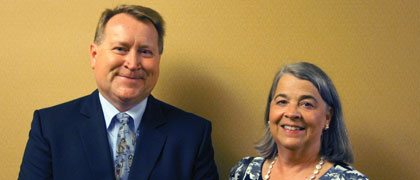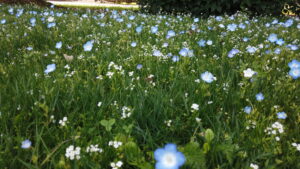The Need for Uniformity Unites
New collaborations between the seed industry and seed testing laboratories give way to the promise of achieving uniformity among test results.
The whole notion of science is based on the premise that a particular theory or hypothesis being tested can be proven and replicated by others. For the seed industry, this notion of science hasn’t quite held up when it comes to results from seed testing, especially for the conservation and native seed industries.
“With respect to non-market issues, the lack of uniformity and consistency among seed testing results is one of the biggest issues,” says Andy Ernst, vice president of Ernst Conservation Seeds in Meadville, Pennsylvania. “Without uniformity in seed testing, it’s hard for us to know exactly what we are selling and giving to our customer, especially in an industry where the value of the seed is based on the purity and germination determined by the test. This value is known as a Pure Live Seed, or PLS, test.”
The Association of Seed Analysts’ (AOSA) president Susan Reed explains that the purpose of a laboratory test is to help establish truth in labeling. “All seeds marketed and sold in the United States must be labeled,” Reed says. “As part of the purity test, we are separating out inert matter, weed seeds and other crops from the pure seed.
“We also do a noxious test that looks for noxious weeds, such as Johnsongrass, which can take over a field and aren’t easily controlled using general agricultural practices. If we find a prohibited weed seed, then that seed may not be sold in our state.”
Reed explains that to get the purity percentage, lab technicians take a subsection of a sample and separate the seed from the inert matter and weigh each. For the germination test, she says the technicians plant the seed from the sample and compare the germination rates to that of the label.
“If the test results are out of tolerance with the label, we issue a violation,” Reed says. “If there is a violation, it doesn’t mean that the seed can’t be sold, it just means the seed must be relabeled so there is truth in labeling.”
Truth in labeling is important, Reed says, because every decision after the lab test is based off of it. For example, if a farmer is looking to purchase cover crop seed, he or she doesn’t need certified foundation seed and might be willing to purchase a lower germination rate at a better price, Reed says. But the seed buyer needs to know the correct germination rate so the seeding rate can be adjusted accordingly, she adds.
Despite some of the inconsistencies in lab results, Ernst says “as an industry, we all try to use what we believe to be the correct information.” But he explains that the lack of uniformity from test to test makes it difficult to have confidence in the label. “The seed test results are used to represent the germination rate and viability of our products,” Ernst says. “They have a direct impact on our profitability.”
Ernst gives the example of sending three samples of seed from the same lot to three different laboratories. He says the expectation is that the germination results would all come back within a few points of each other. “But when the results from those three samples come back with significantly different germination rates, which one should be used to set the value?” he asks. “Which one is correct?”
“These tests mean the difference between a seed lot being worth hundreds of dollars or thousands of dollars. This is real money and a 10-point swing among tests is a huge swing in profitability,” Ernst says.
Not only that, but Ernst says that if a seed lot were labeled as X percent for the germination rate and he was to be audited with the second test coming back as Y, then his company would be subject to a penalty fine, too.
Reed acknowledges the importance of consistency and uniformity from test to test. “We need to get it right because decisions are based off of what we do,” she says.
Helping to lead the way in achieving uniformity in seed testing, Neal Foster and Susan Reed, work to identify areas for improvement.
Diversity Creates Difficulty
Testing native and conservation seeds is no easy task. There are hundreds of native seed species, and with native seed varieties, Ernst says there are multiple dormancies. For instance, when planting corn, the expectation is that all the seed will germinate within a few days of each other and very uniformly. But when planting a field of switchgrass, Ernst says that some will germinate in two to four weeks and some might not germinate for two years.
“It’s really a tough thing to do because these situations are not cut-and-dry,” Ernst says. “And as an industry, it’s important to acknowledge that.”
Native and conservation seeds are one of the most difficult crops to maintain consistency with, says Neal Foster, president of the Society of Commercial Seed Technologists. “There’s usually high inert matter, it doesn’t flow well and it’s hard to get a uniform seed lot,” he says, noting that these issues only compound one another.
AOSA’s Reed likes to compare seeds to snowflakes. “There are no two alike,” she says. “Seeds are not always uniform and you are going to get different results.”
Reed gives the example of someone in Oregon growing and harvesting grass seed. Once that seed is harvested, it goes through dormancy, she explains. From the warehouse it might be shipped across the United States in mid-July. Upon arrival, the characteristics and value of the seed will be different from just after harvest, she explains.
“This is especially true with native seeds used for land reclamation and restoration,” she says. “These seeds are difficult to germinate but we are trying to get more consistency in results from laboratory to laboratory and test to test. We have found that it’s difficult to get lab results that are even compatible within a tolerance.”
Several factors influence seed quality. “You have blending of lots, transportation and storage,” she says. “Sometimes lots are not uniform. Then you must also consider the time from when the seed is shipped to when it is tested — what elements has it been exposed to? Seed can be damaged by living organisms and by heat.”
While so many variables are out of anyone’s control, Reed says that they should be able to control uniformity of testing.
Another issue that Reed says has been plaguing AOSA’s seed testing laboratories is the inability to hire and retain quality technicians. “We have states that are in dire straits because labs have lost funding,” she says. “It’s incredibly hard to keep people in the laboratories because of the low compensation; they can easily go to industry for an extra $20,000 a year. We test 325 different types of seed and as soon as people become competent, they transition.”
Reed says she’s worried that the seed testing industry is going to reach a critical mass where there aren’t enough people filling these roles to serve industry needs. “At some point, this is going to have to be addressed,” she says. While admitting that this doesn’t directly impact the uniformity issue, Reed says it could certainly play a role.
Paving a Path Forward
Uniformity and consistency in seed testing is not a new issue, but new steps are being taken to address it. In 2013, the boards of directors for AOSA and SCST began pursuing a number of initiatives to determine if multiple germination testing methods in the AOSA Rules for Testing Seeds results in a lack of uniformity in seed testing results. The ru
lebook includes procedures for 677 kinds of seed with 430 species/kinds citing multiple procedures for determining the rate of germination.
Project manager Richard Payne of G&P Consulting has created a survey to be sent to all seed testing laboratories, asking which test methods they use and why. “The goal of this survey is to improve the AOSA Rules for Testing Seeds,” Payne says.
Foster adds that the survey will help to identify testing methods that could potentially be removed from the rulebook, which would help to tighten protocols and eliminate inconsistencies.
AOSA and SCST are also evaluating their training opportunities and working to identify areas that can be improved. “We can do a better job of making sure everyone between all the AOSA and SCST labs is following AOSA guidelines,” Reed says, noting that they host webinar trainings for professional development and work with Iowa State University and the University of California, Davis, on workshop programming. She says they are also working to host more regional meetings to help keep travel costs down so those labs with tighter budgets can still participate in professional development opportunities.
Additionally, a seed uniformity task force has been developed. Spearheaded by the American Seed Trade Association, the task force consists of two representatives from AOSA, two representatives from SCST, one from ASTA, one from the Association of American Seed Control Officials and one from the Association of Official Seed Certifying Agencies (AOSCA).
“We are developing a plan that improves uniformity of seed testing,” Reed says. “It’s going to take the entire value chain to get there.”
Foster says the task force is looking at various governance structures for seed laboratories, how to improve consistency in testing, the accreditation of laboratories and quality management systems, and improved methods for the testing process.
While it’s going to take time, Foster says the biggest obstacle was getting everybody on the same page and in the same room. “Collaboration is extremely important because we all play a small part in the large scheme of things,” Foster says. “To get anything done of this magnitude, we all have to work together.”
AOSCA’s representative, Alan Galbreth of Indiana Crop Improvement Association, says this is a very positive step for the entire industry. “We know there are some issues with seed testing uniformity and each lab tends to get locked into their own way of doing things,” he says. “We’ve discovered there can be some pretty different interpretations of the rules.”
Galbreth says the task force is currently focused on very broad issues and that as they hone in on more specific ones, working groups will likely be developed and more people brought into the process.
While progress is being made, Ernst acknowledges that it’s going to take a long time before there is uniformity in seed testing. “Progress will be slow because everything has to first be proven scientifically,” he says. “These types of discussions are a huge step forward to improving uniformity among seed tests.”
For Ernst, the end goal is to receive a number from seed testing laboratories that allows him to assign a value to seed lots with confidence. “Even if that number is only a 50, if that number can be repeated and consistently shows a value within tolerance, that’s what we want,” he explains. “The actual number is not as important to us as repeatability, which we use to compare one lot to another.”
Julie Deering













